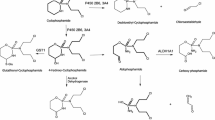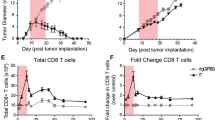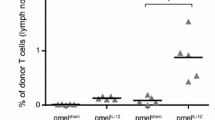Summary
We investigated the in vivo effects of cyclophosphamide (CY) on interleukin-2(IL-2)-induced cytolytic function and spleen cell immunophenotype. Pretreatment of A/J mice with CY (25 mg/kg or 75 mg/kg) i.p. on days −10 and −15 followed by IL-2 (50 000 U i.p. on days 0 to +3) resulted in increased lysis of YAC-1 target cells compared to the group receiving IL-2 without previous CY therapy. In contrast, when CY was given on day -5, the cytotoxicity against YAC-1 was not enhanced. Phenotypic analysis of splenocytes obtained from mice treated with CY on day −10 or −15 revealed a relative decrease in L3T4- and Lyt2-positive T cells. In vivo depletion of natural killer (NK) cells by anti-asialoGM1, prior to IL-2 therapy, abrogated the enhancing effect of CY on cytolysis while in vivo elimination of T cells by anti-L3T4 and anti-Lyt2 monoclonal antibodies did not, indicating that in the absence of T cell antigenic challenge, the increased cytolytic function after CY administration is probably mediated through NK cells. These findings provide evidence that CY may be used more effectively in IL-2-based immunotherapy protocols, if consideration is given to timing of CY and IL-2 administration.
Similar content being viewed by others
References
Abe F, Schneider M, Black PL, Talmadge JE (1989) Chemoimmunotherapy with cyclophosphamide and bestatin in experimental metastasis in mice. Cancer Immunol Immunother 29: 231
Awwad M, North RJ (1989) Cyclophosphamide-induced immunologically mediated regression of a cyclophosphamide-resistant murine tumor: a consequence of eliminating precursor L3T4+ suppressor T-cells. Cancer Res 49: 1649
Ballas ZK (1986) Lymphokine-activated killer (LAK) cells: differential recovery of LAK, natural killer cells, and cytotoxic T lymphocytes after a sublethal dose of cyclophosphamide. J Immunol 137: 2380
Berd D, Mastrangelo MJ, Engstrom PF, Paul A, Maguire H (1982) Augmentation of human immune response by cyclophosphamide. Cancer Res 42: 4862
Berd D, Maguire HC, Mastrangelo MJ (1986) Induction of cell-mediated immunity to autologous melanoma cells and regression of metastases after treatment with a melanoma cell vaccine preceded by cyclophosphamide. Cancer Res 46: 2572
Eberlein TJ, Massaro A, Jung S, Rubinstein A, Burger U, Chang M, Schoof DD (1989) Cyclophosphamide immunosuppression potentiates tumor infiltrating lymphocyte therapy in the mouse. Proc Am Assoc Cancer Res 30: 371
Eggermont AMM, Sugarbaker PH (1988) Efficacy of chemoimmunotherapy with cyclophosphamide, interleukin-2 and lymphokine activated killer cells in an intraperitoneal murine tumor model. Br J Cancer 58: 410
Greenberg PD, Kern DE, Cheever MA (1985) Therapy of disseminated murine leukemia with cyclophosphamide and immune Lyt-1+, 2-T cells. J Exp Med 161: 1122
Habu S, Fukui H, Shimamura M, Kasai M et al (1981) In vivo effects of anti-asialo-GM1: Reduction of NK activity and enhancement of transplanted tumor growth in nude mice. J Immunol 127: 34
Hoover SK, Barrett SK, Turk TMT, Lee T, Bear HD (1990) Cyclophosphamide and abrogation of tumor-induced suppressor T cell activity. Cancer Immunol Immunother 31: 121
Kasai M, Iwamori M, Nagai Y et al (1980) A glycolipid on the surface of mouse natural killer cells. Eur J Immunol 10: 175
Kedar E, Ben-Aziz R, Epstein E, Leshem B (1989) Chemoimmunotherapy of murine tumors using interleukin-2 (IL-2) and cyclophosphamide. Cancer Immunol Immunother 29: 74
Kim R, Lafreniere R, Borkenhagen K, Bryant LD (1989) Induction of cytotoxicity from fresh splenocytes after in vivo administration in cyclophosphamide. Cancer Immunol Immunother 30: 283
Lafreniere R, Borkenhage K, Bryant LD, Ng E (1989) Enhancement of tumor infiltrating lymphocytes cytotoxicity by cyclophosphamide given systemically prior to tumor harvest. Proc Am Assoc Cancer Res 30: 385
Markovic SN, Murasco DM (1991) Role of natural killer and T-cells in interferon induced inhibition of spontaneous metastases of B16F10L murine melanoma. Cancer Res 51: 1124
North RJ (1982) Cyclophosphamide-facilitated adoptive immunotherapy of an established tumor depends on elimination of tumor-induced suppressor T cells. J Exp Med 55: 1063
Papa MZ, Yang JC, Vetto JT, Shiloni E, Eisenthal A, Rosenberg SA (1988) Combined effects of chemotherapy and interleukin-2 in the therapy of mice with advanced pulmonary tumors. Cancer Res 48: 122
Riccardi C, Barlozzari T, Santoni A, Herberman RB, Cesarini C (1981) Transfer to cyclophosphamide-treated mice of natural killer (NK) cells and in vivo natural reactivity against tumors. J Immunol 126: 1284
Rosenberg SA, Spiess P, Lafreniere R (1986) A new approach to adoptive immunotherapy of cancer with tumor-infiltrating lymphocytes. Science 223: 1318
Rosenberg SA, Packard BS, Aebersold PM, Solomon D, Topalian SL, Toy ST, Simon P, Lotze MT, Yang JC, Seipp CA, Simpson C, Carter C, Bock S, Schwatzentruber D, Wei JP, White DE (1988) Use of tumor infiltrating lymphocytes and interleukin-2 in the immunotherapy of patients with metastatic melanoma. N Engl J Med 319: 1676
Rubin JT, Elwood LJ, Rosenberg SA, Lotze MT (1989) Immunohistochemical correlates of response to recombinant interleukin-2 based immunotherapy in humans. Cancer Res 49: 7086
Sahasrabudhe DM, de Kernion JB, Pontes JE, Ryan DM, O'Donnell RW, Marquis DM, Mudholkar GS, McCune CS (1986) Specific immunotherapy with suppressor function inhibition for metastatic renal cell carcinoma. J Biol Response Mod 5: 581
Silagi S, Schaefer AE (1986) Successful immunotherapy of mouse melanoma and sarcoma with recombinant interleukin-2 and cyclophosphamide. J Biol Response Mod 5: 411
Stockman GD, Heim LR, South MA, Trentin JJ (1973) Differential effects of cyclophosphamide on the B and T cell compartments of adult mice. J Immunol 110: 277
Author information
Authors and Affiliations
Additional information
Supported in part by the Children's Cancer Research Fund, the Concern II Foundation, RO1-CA-21 737, NO1-AI-85 002 and a contract to the University of Minnesota from OncoTherapeutics Inc. Dr. E. Katsanis is supported by a fellowship from the Medical Research Council of Canada. Dr. P. M. Anderson is supported by a Clinical Oncology Career Development Award from the American Cancer Society. This is paper no. 550 of the Immunobiology Research Center
Rights and permissions
About this article
Cite this article
Katsanis, E., Bausero, M.A., Ochoa, A.C. et al. Importance in timing of cyclophosphamide on the enhancement of interleukin-2-induced cytolysis. Cancer Immunol Immunother 34, 74–78 (1991). https://doi.org/10.1007/BF01741339
Received:
Accepted:
Issue Date:
DOI: https://doi.org/10.1007/BF01741339




